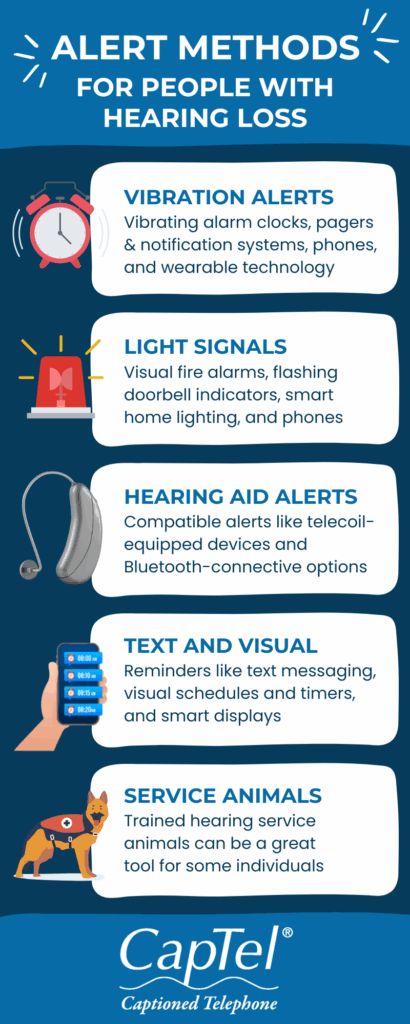Let’s take a look at some alternative alert systems for people who are hard of hearing.

Traditional ringing or sound-based alert systems may not be ideal or as safe for people with hearing loss. There are a variety of options and different technology based around vibrating or visual alert systems that can be safer and more helpful. In this blog, we’ve gathered some different alert methods for people with hearing loss to help you find what alerts or systems work best for your preferences. Let’s take a look:
Vibration Alerts
One of the most common and versatile alternatives to sound is vibration. Devices utilizing vibration can be used in numerous ways:
- Vibrating Alarm Clocks: These powerful alarms, often placed under a pillow, provide a tactile way to wake up without relying on sound. Some models even offer adjustable vibration intensity.
- Pagers and Notification Systems: Compact devices or smartphone integrations can deliver alerts through vibrations for various events, such as doorbells ringing, babies crying on a monitor, phone calls, and severe weather warnings broadcast through specialized networks.
- Phones: Your phone’s ringtone can be complemented by a vibration to notify you of an incoming text, call, or other notification. This can be easily adjusted in the settings.
- Wearable Technology: Smartwatches and fitness trackers often offer customizable vibration alerts for calls, messages, and app notifications, providing discreet and personal alerts.
Light Signals
Visual cues are another effective way to convey alerts. Light-based systems come in different forms:
- Visual Fire Alarms: These devices pair traditional audible alarms with bright, flashing strobe lights, ensuring individuals who cannot hear the siren are still alerted to a fire.
- Flashing Doorbell Indicators: When the doorbell rings, a connected light inside the home will flash, visually signaling a visitor.
- Smart Home Lighting: Some devices, like ovens or laundry machines, may offer light-based notifications when the cycle is finished or a timer is done.
- Phones: Your cell phones or home phones may be equipped with flashing light indicators. CapTel phones offer light signals when a call is incoming so you can be notified someone is trying to reach you. Your cell phone may have this option in settings as well.
Hearing-Aid Compatible Noise Alerts:
Some alert systems are designed to work well with hearing aids:
- Telecoil-Equipped Devices: Many public alert systems, like those in theaters or airports, utilize induction loop technology. Hearing aids with a telecoil (T-coil) can directly receive these audio signals, reducing background noise and improving clarity.
- Bluetooth Connectivity: Modern hearing aids often connect via Bluetooth to smartphones and other devices, allowing for direct streaming of calls, notifications, and even specialized alert sounds optimized for individual hearing profiles.
Text and Visual Reminders:
Leveraging visual communication can be highly effective for reminders and less urgent alerts:
- Text Messaging: Simple SMS messages can serve as reminders for appointments, medication times, or other important events.
- Visual Schedules and Timers: Displaying schedules and using visual timers can help individuals stay organized and aware of upcoming activities without relying on auditory cues.
- Smart Displays: Devices like smartphones or tablets with screens can show visual reminders, upcoming calendar events, and even video calls.
Service Animals
For some individuals, a trained service dog can provide an invaluable alerting support. These animals can be trained to recognize specific sounds, such as doorbells, alarms, or a crying baby, and then physically alert their owner. If you are interested in a hearing service animal, discuss your options with your healthcare provider.
The best alert method often depends on your individual needs, lifestyle, and communication preferences. Many people find that a combination of different systems provides the most comprehensive coverage. Exploring your options and consulting with your audiologist can help you make the right choice for your needs. For additional resources, visit the CapTel blog.


